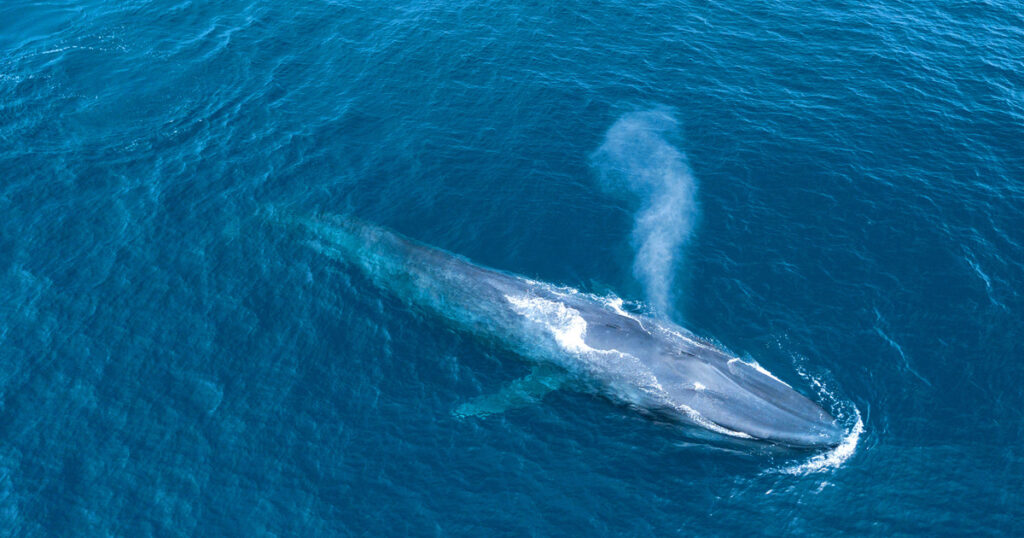
The blue whale, the largest animal known to have ever existed, roams the oceans with few natural predators. However, it does face threats from certain marine animals and more significantly, from human activities. This article explores the blue whale’s primary enemies, focusing on orcas and human-induced dangers, while also discussing how these threats impact their survival.
The Blue Whale: An Overview
Blue whales can grow up to 100 feet long and weigh as much as 200 tons. These magnificent creatures primarily feed on tiny shrimp-like animals called krill, consuming up to 4 tons of krill each day during feeding seasons. Their immense size and strength make them relatively safe from most predators in the ocean. However, they are not entirely free from threats.
The Orca: The Blue Whale’s Only Known Predator
Characteristics of Orcas
Orcas, also known as killer whales (scientific name: Orcinus orca), are the only marine animals known to attack blue whales. These apex predators are highly intelligent and social creatures that live in pods. Orcas can grow up to 32 feet long and weigh up to 12,000 pounds, making them one of the largest members of the dolphin family.
Attack Strategies
Orcas have been observed hunting blue whales in groups, using sophisticated strategies to overpower their massive prey. They often target younger or weaker blue whales, as attacking a healthy adult can be dangerous. During these hunts, orcas may work together to keep the blue whale submerged and exhaust it before delivering fatal bites.Despite these predatory behaviors, confirmed cases of orcas successfully killing blue whales are rare. Most interactions result in scarring rather than death, indicating that while orcas can pose a threat, they do not frequently succeed in killing adult blue whales.
Human Threats to Blue Whales
While orcas represent a natural predator, human activities pose a much more significant threat to blue whales. Here are some of the primary human-induced dangers:
1. Ship Strikes
One of the most dangerous threats to blue whales is ship strikes. As these whales migrate across oceans, they often encounter large vessels that can collide with them. These collisions can cause severe injuries or death to blue whales. Efforts are being made to reduce ship speeds in areas where blue whales are known to frequent, but incidents still occur.
2. Climate Change
Climate change is another critical threat facing blue whales. Rising sea temperatures and ocean acidification affect krill populations—the primary food source for blue whales. Changes in ocean conditions can disrupt krill breeding cycles and distribution, making it harder for blue whales to find food.
3. Noise Pollution
Noise pollution from shipping traffic, industrial activities, and naval exercises can interfere with the communication and navigation abilities of blue whales. These sounds can mask the low-frequency calls that blue whales use to communicate over long distances, potentially affecting their ability to find mates and navigate effectively.
4. Historical Whaling
Although commercial whaling has been banned since 1966 and populations are slowly recovering, historical whaling practices significantly reduced blue whale numbers. Over 330,000 blue whales were killed during the whaling era, pushing them close to extinction. The legacy of this hunting still impacts their recovery today.
Summary Table: Blue Whale’s Enemies
| Threat | Description | Impact |
|---|---|---|
| Orcas | The only known predator capable of attacking blue whales; hunts in pods | Rarely kills adults; mostly causes scarring |
| Ship Strikes | Collisions with large vessels during migration | Can cause severe injuries or death |
| Climate Change | Rising sea temperatures affecting krill populations | Disrupts food supply |
| Noise Pollution | Interference from shipping and industrial sounds | Affects communication and navigation |
| Historical Whaling | Past hunting practices drastically reduced populations | Long-term impacts on recovery efforts |
Conclusion
In conclusion, while the blue whale has few natural enemies due to its size and strength, it faces significant threats from orcas and human activities. Orcas represent a natural challenge but rarely succeed in killing adult blue whales. In contrast, human-induced threats like ship strikes, climate change, noise pollution, and historical whaling have profound impacts on their survival.Understanding these threats is crucial for conservation efforts aimed at protecting blue whales and ensuring their continued existence in our oceans. As we continue to learn about these magnificent creatures and their challenges, it becomes increasingly important to advocate for measures that safeguard their habitats and promote healthier ocean ecosystems.





